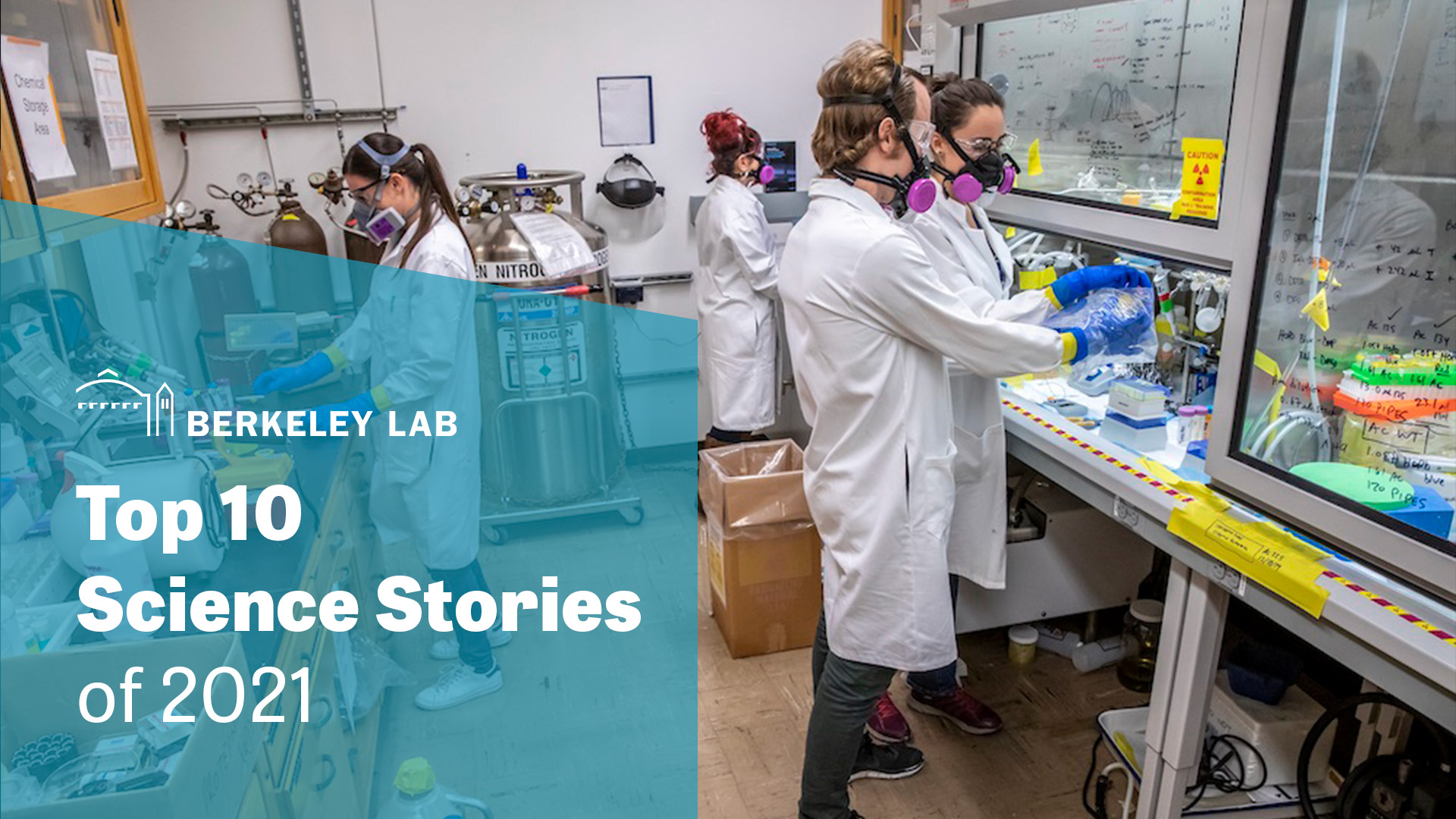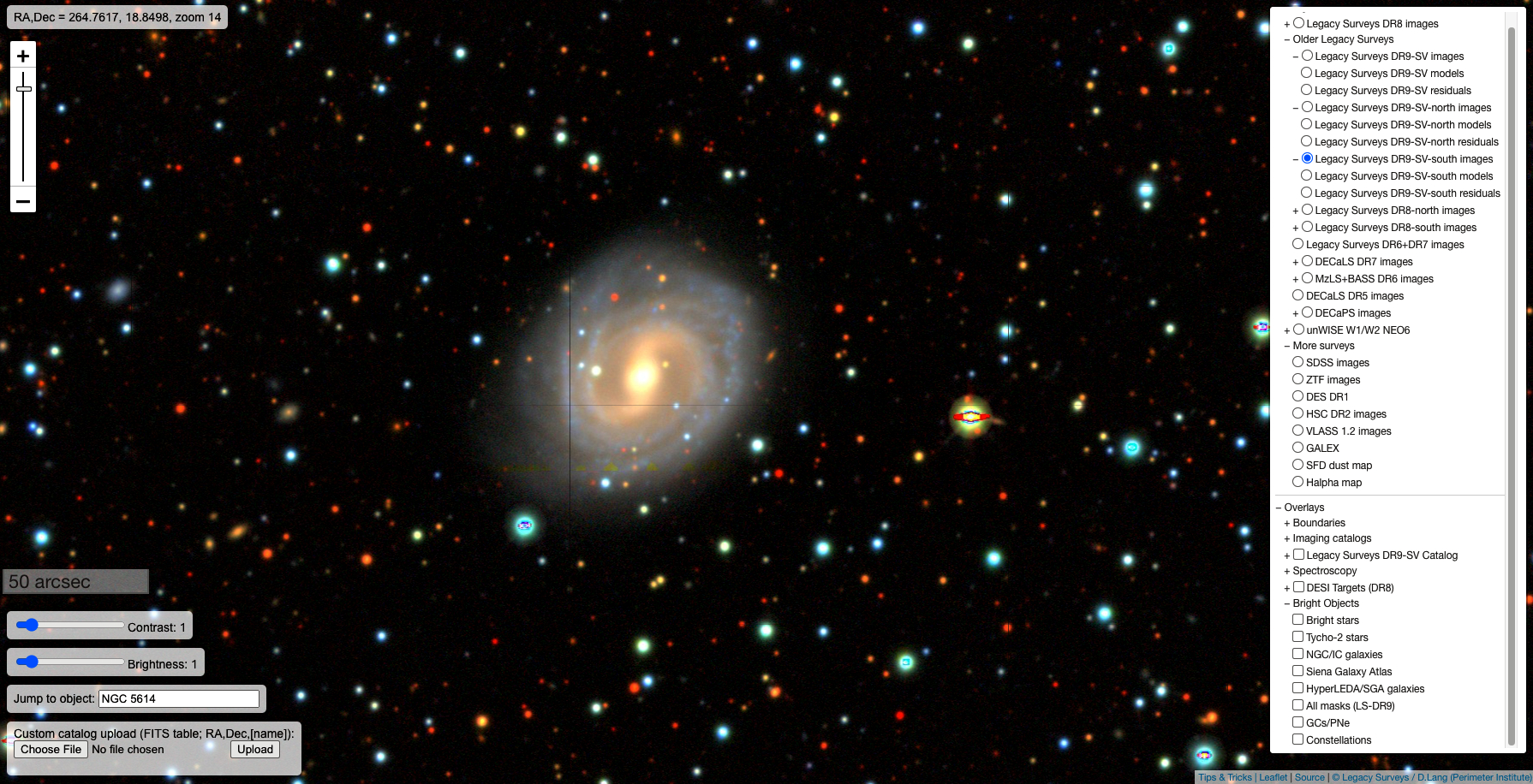While the COVID-19 pandemic continued to be ubiquitous in science headlines in 2021, the urgency of the ongoing climate crisis became impossible to ignore. The Intergovernmental Panel on Climate Change released its Sixth Assessment Report and world leaders gathered in Glasgow for a climate summit to negotiate how they will cut emissions.
Year in Review: Photos
View highlights of 2021 by Berkeley Lab photographers.
Year in Review: Videos
Some of our most popular videos of 2021 were:
Berkeley Lab: What’s in a Name? ![]()
Rapid Research Response for Mitigating Post-Wildfire Effects![]()
Black Carbon Sensors Give Air Pollution Data to Richmond Residents![]()
At Lawrence Berkeley National Laboratory (Berkeley Lab) researchers continued to work at understanding and solving these difficult challenges. And it announced a number of new scientific capabilities that will aid in reaching their goals:
- The unveiling of its next-generation supercomputer, Perlmutter, named after the Lab’s Nobel Prize-winning astrophysicist Saul Perlmutter, to bolster scientific research.
- A mountain climate observatory in the Rockies, to allow scientists to predict the future of water availability in the West.
- A high-tech growing chamber called an EcoPOD to study how plants respond to climate change.
- A quantum network testbed, to be built with UC Berkeley and Caltech, paving the way for a nationwide quantum internet.
In July, in an effort coordinated by Berkeley Lab, all seventeen U.S. national laboratories and many prominent publishers, journals, and other organizations in scientific publishing announced the beginning of a partnership to support name change requests from researchers on past published papers. The agreement allows researchers who have changed their names to more easily claim work from all stages of their careers; it specifically addresses the administrative and emotional difficulties some transgender researchers have experienced when requesting name changes associated with past academic work.
Berkeley Lab’s most popular science stories of 2021 are as follows.
Led by researchers Erica Siirila-Woodburn and Alan Rhoades, this review paper analyzed previous climate projections and found that if greenhouse gas emissions continue along the high-emissions scenario, low-to-no-snow winters will become a regular occurrence in the western U.S. in 35 to 60 years. But the study also noted possible solutions. The authors stressed that scientists and water managers need to work together more closely to develop and implement climate adaptation strategies.
The study was widely covered in the media, including in the Washington Post, Los Angeles Times, San Francisco Chronicle, and Jefferson Public Radio.
A room-temperature magnet that’s just an atom thin? That may sound like something straight out of science fiction, but in a physics first, a research team led by Berkeley Lab reported such a device in Nature Communications. The new material – which can be bent into almost any shape without breaking, and is a million times thinner than a sheet of paper – could help advance the application of spin electronics or spintronics, a new technology that uses the orientation of an electron’s spin rather than its charge to encode data.
“This discovery is exciting because it not only makes 2D magnetism possible at room temperature, but it also uncovers a new mechanism to realize 2D magnetic materials,” said Rui Chen, a UC Berkeley graduate student in the Yao Research Group and lead author on the study.
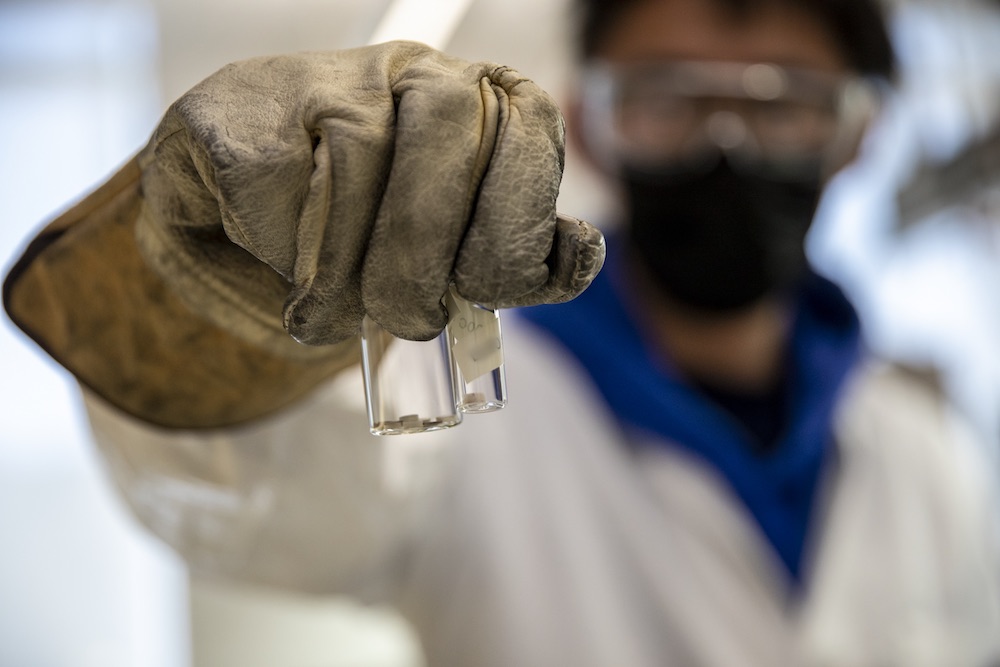
Jingyang Wang holds up a ceramic palette sample in the battery lab. (Credit: Marilyn Sargent/Berkeley Lab)
In our future electrified world, the demand for battery storage is projected to be enormous, but the lithium-ion battery has a component made of cobalt and nickel, and those two metals face severe supply constraints on the global market. Berkeley Lab scientists led by Gerbrand Ceder and Guoying Chen have made significant progress in developing battery cathodes using a new class of materials that can be made of inexpensive and abundant metals – and provide batteries with the same if not higher energy density than conventional lithium-ion batteries. Known as DRX, which stands for disordered rocksalts with excess lithium, this novel family of materials was invented less than 10 years ago and allows cathodes to be made without nickel or cobalt.
“The classic lithium-ion battery has served us well, but as we consider future demands for energy storage, its reliance on certain critical minerals exposes us not only to supply-chain risks, but also environmental and social issues,” said Ravi Prasher, Berkeley Lab’s Associate Lab Director for Energy Technologies. “With DRX materials, this offers lithium batteries the potential to be the foundation for sustainable battery technologies for the future.”
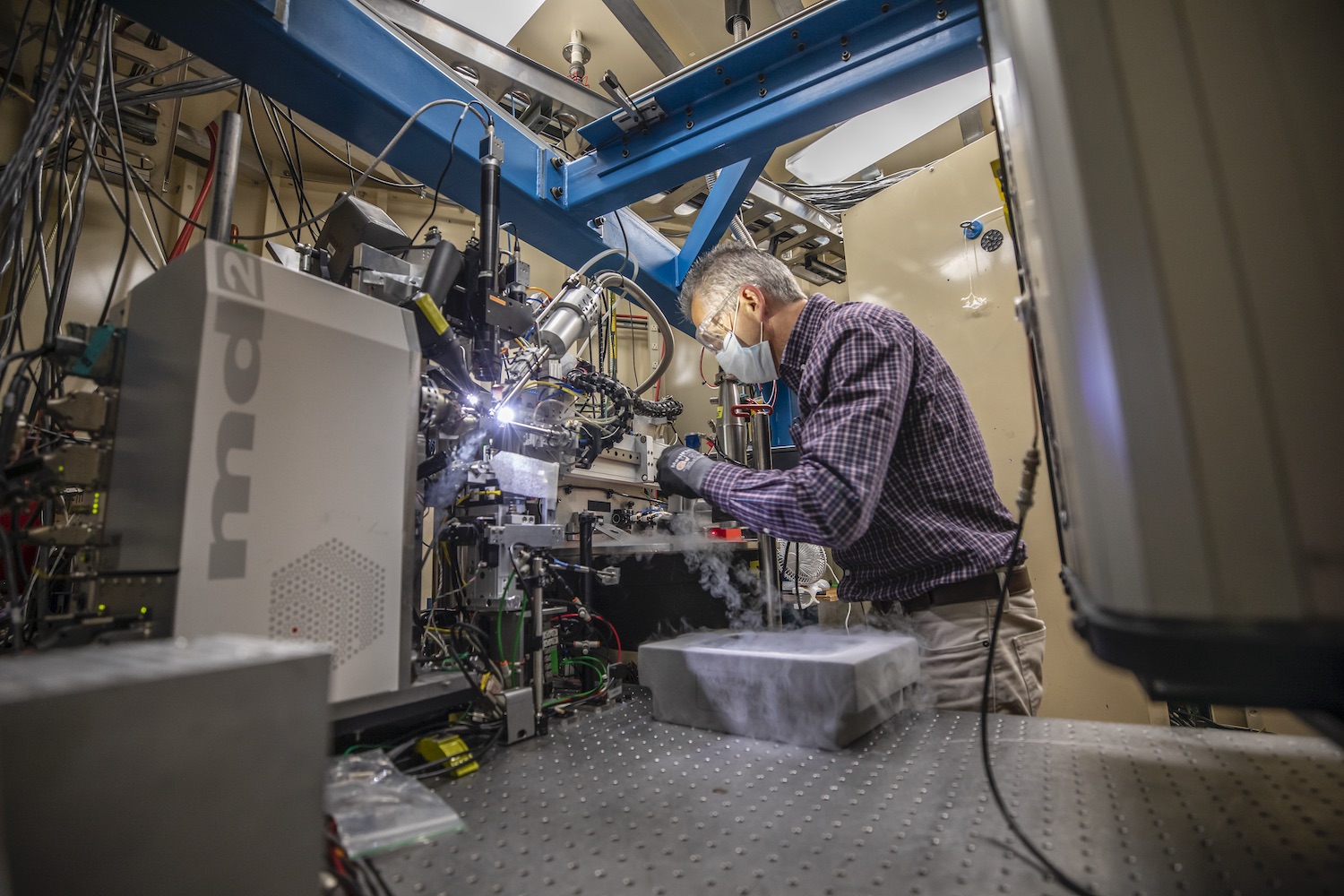
Marc Allaire, pictured in June 2020, setting up one of the Advanced Light Source’s crystallography beamlines for a COVID-19 research project. (Credit: Marilyn Sargent/Berkeley Lab)
A group of longtime collaborators pooled their expertise to investigate the structure of ORF8, a SARS-CoV-2 protein that appears to play a key role in the newly emerged virus’s ability to cause severe infections in humans.
The team of structural biology and virology experts from Berkeley Lab and UC Berkeley threw themselves into overdrive to purify and prepare samples of the protein early on in the pandemic, then built a map of its structure using X-ray crystallography data and sophisticated computer algorithms. Their work was published open-access so that the global scientific community could use the structure to study the virus’s evolution, and design potential treatments.
Since buildings consume 75% of electricity in the U.S., they offer great potential for saving energy and reducing the demands on our rapidly changing electric grid. But how much, where, and through which strategies could better management of building energy use actually impact the electricity system? A comprehensive new study led by Berkeley Lab researchers answered these questions, quantifying what can be done to make buildings more energy efficient and flexible in granular detail by both time (including time of day and year) and space (looking at regions across the U.S.).
The research team, which also included scientists from the National Renewable Energy Laboratory (NREL), found that maximizing the deployment of building demand management technologies could avoid the need for up to one-third of coal- or gas-fired power generation and would mean that at least half of all such power plants that are expected to be brought online between now and 2050 would not need to be built.
Most of the universe – nearly 70% – is made of the mysterious dark energy, which is speeding up the expansion of the universe. But physicists still don’t really know what dark energy is. To learn more about it, Berkeley Lab scientists have led a collaboration of about 600 physicists at 54 institutions around the world to build the Dark Energy Spectroscopic Instrument (DESI). Over the next five years, DESI will create the largest-ever 3D map of the universe, yielding answers about the history – and future – of the expansion of the universe.
But before DESI could start its survey in May of this year, scientists needed to build another map, one that DESI could use to plan out its survey. This 2D map combined 200,000 telescope images and several years of satellite data, with images of over a billion galaxies. “This is the biggest map by almost any measure,” said David Schlegel, co-project scientist for DESI and a cosmologist at Berkeley Lab. This detailed sky map has opened the door to a variety of scientific work beyond DESI – and it’s freely available to the public, too.
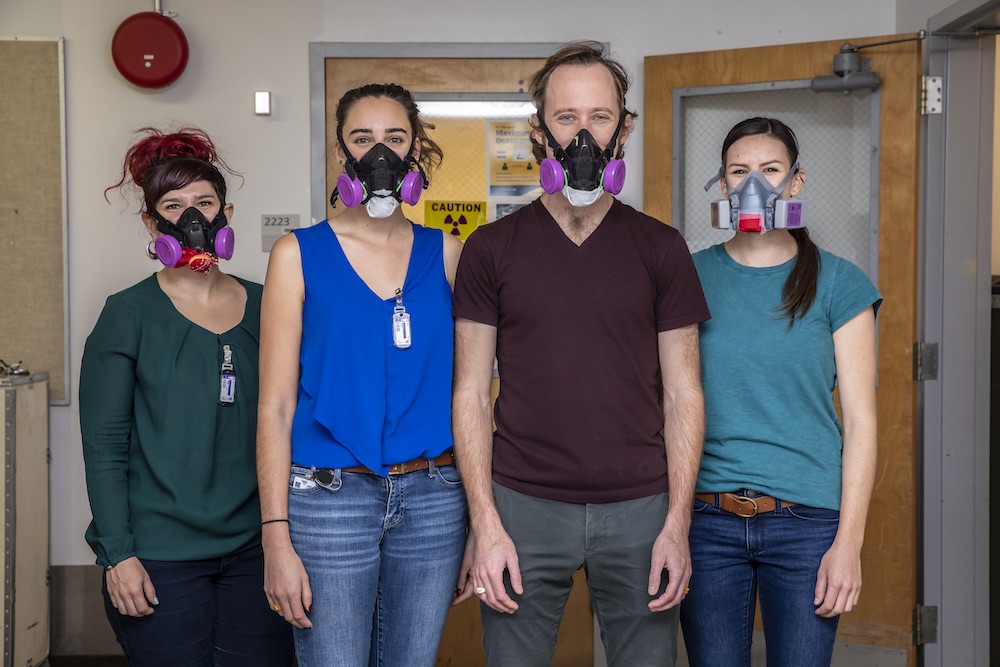
Berkeley Lab scientists Leticia Arnedo-Sanchez (from left), Katherine Shield, Korey Carter, and Jennifer Wacker. (Credit: Marilyn Sargent/Berkeley Lab)
Since element 99 – einsteinium – was discovered in 1952 from the debris of the first hydrogen bomb, scientists have performed very few experiments with it because it is so hard to create and is exceptionally radioactive. A team of Berkeley Lab chemists overcame these obstacles to report the first study characterizing some of its properties, opening the door to a better understanding of the remaining transuranic elements of the actinide series.
“There’s not much known about einsteinium,” said Rebecca Abergel, lead author of the study, published in Nature. “It’s a remarkable achievement that we were able to work with this small amount of material and do inorganic chemistry. It’s significant because the more we understand about its chemical behavior, the more we can apply this understanding for the development of new materials or new technologies, not necessarily just with einsteinium, but with the rest of the actinides too. And we can establish trends in the periodic table.”
This achievement was covered in the New York Times, NBC News, Chemistry World, Vice, and others.
Our revolutionary infinitely recyclable plastic isn’t just a pretty prototype. This comprehensive analysis showed that an industrial scale rollout of the new material (invented by Berkeley Lab scientists in 2019) could be cheap and easy enough to compete with conventional plastics, while also sparing our increasingly overloaded landfills and reducing the energy consumption and emissions associated with the production and recycling processes.
“Plastics were never designed to be recycled. The need to do so was recognized long afterward,” explained Nemi Vora, first author on the study. The new plastic, called PDK, “was designed to be recycled from the get-go, and since the beginning, the team has been working to refine the production and recycling processes for PDK so that the material could be inexpensive and easy enough to be deployed at commercial scales in anything from packaging to cars.”
The research was covered in Fast Company, Forbes, Triple Pundit, Earth 911, and more.

An artistic rendering of antibodies surrounding a SARS-CoV-2 particle. (Credit: ktsdesign/Shutterstock)
A successful new COVID-19 antibody therapy called sotrovimab, which was given expedited emergency approval by the FDA earlier this year, was developed with help from bioimaging whiz Jay Nix, leader of the Molecular Biology Consortium based at Berkeley Lab’s Advanced Light Source.
Nix pulled on his decades of experience in crystallography to help a research team screen antibodies found in blood samples taken from SARS survivors in the early 2000s. His work helped generate detailed structural maps of how these antibodies can bind to and inhibit the SARS-CoV-2 spike protein, allowing the wider team – led by Vir Biotechnology – to select the most promising contenders and evaluate them in clinical trials. One antibody, dubbed S309, was found to neutralize all known SARS-CoV-2 strains, including newly emerged mutants that can now “escape” from previous antibody therapies, as well as the closely related original SARS-CoV virus.
Sotrovimab was designed from the structure of S309, and the therapy was granted an emergency use authorization in late May, after trials showed that COVID-19 patients who received an infusion of the antibodies had an 85% reduction in rates of hospitalization or death, compared with a placebo treatment.
This story was picked up by and trended on Reddit science forums r/EverythingScience and r/Futurology.
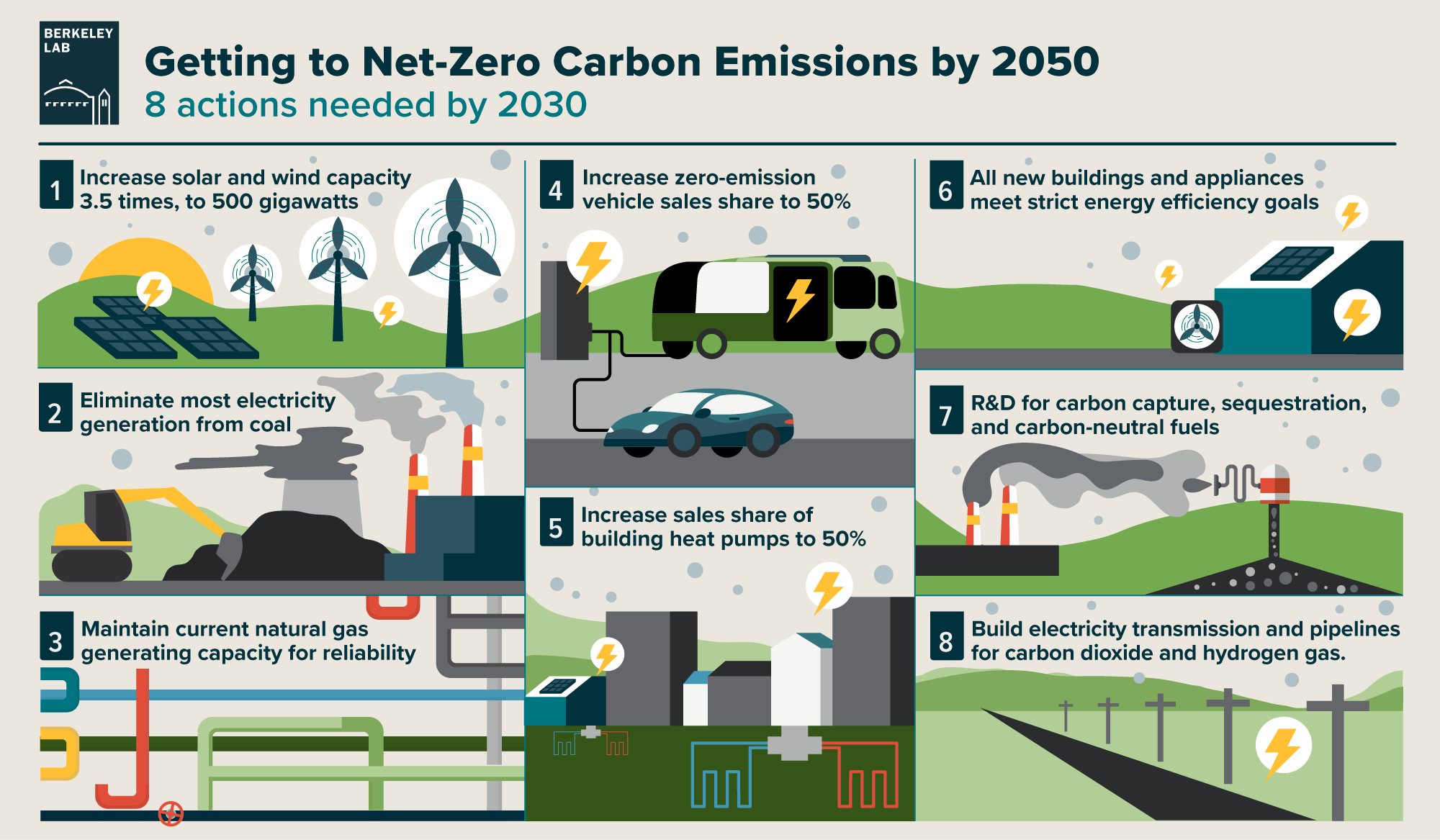
Regardless of the pathway we take to become carbon neutral by 2050, the actions needed in the next 10 years are the same. (Credit: Jenny Nuss/Berkeley Lab)
Researchers from Berkeley Lab, the University of San Francisco, and the consulting firm Evolved Energy Research created a detailed model of the entire U.S. energy and industrial system to produce the first detailed, peer-reviewed study of how to reach zero net emissions of carbon dioxide from energy and industry by 2050. They found that it can be accomplished by rebuilding U.S. energy infrastructure to run primarily on renewable energy, at a net cost of about $1 per person per day.
According to the Intergovernmental Panel on Climate Change (IPCC), the world must reach zero net CO2 emissions by mid-century in order to limit global warming to 1.5 degrees Celsius and avoid the most dangerous impacts of climate change. The researchers developed multiple feasible technology pathways that differ widely in remaining fossil fuel use, land use, consumer adoption, nuclear energy, and bio-based fuels use but share a key set of strategies. “By methodically increasing energy efficiency, switching to electric technologies, utilizing clean electricity (especially wind and solar power), and deploying a small amount of carbon capture technology, the United States can reach zero emissions,” the authors write in “Carbon Neutral Pathways for the United States,” published in the journal AGU Advances.
Finally, 2021 was difficult in a very personal way for Berkeley Lab’s science communications team. Glenn Roberts, a beloved colleague and prolific writer who covered physics, accelerators, and nuclear science, passed away in March. Though we are still reeling from the loss, we are proud of his continued impact as an extraordinary science communicator, which is exemplified by this list’s #5 story on the Dark Energy Spectroscopic Instrument – written just two months before he died as he was privately battling cancer. Roberts’ engaging and accessible articles deftly tackled some of Berkeley Lab’s most head-scratching, mind-bending fundamental research, and wherever possible, emphasized the enduring importance of team science.
# # #
Founded in 1931 on the belief that the biggest scientific challenges are best addressed by teams, Lawrence Berkeley National Laboratory and its scientists have been recognized with 14 Nobel Prizes. Today, Berkeley Lab researchers develop sustainable energy and environmental solutions, create useful new materials, advance the frontiers of computing, and probe the mysteries of life, matter, and the universe. Scientists from around the world rely on the Lab’s facilities for their own discovery science. Berkeley Lab is a multiprogram national laboratory, managed by the University of California for the U.S. Department of Energy’s Office of Science.
DOE’s Office of Science is the single largest supporter of basic research in the physical sciences in the United States, and is working to address some of the most pressing challenges of our time. For more information, please visit energy.gov/science.
